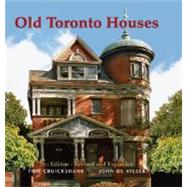
Tom Cruickshank is the author of five books on architectural heritage, as well as Living the Country Dream. He edits Harrowsmith Country Life magazine, and lives on a hobby farm in Port Hope, Ontario.
With over 60 books to his credit, including Canadian Churches: An Architectural History and Old Canadian Cemeteries, John de Visser is one of Canada's most accomplished photographers. A member of the Royal Canadian Academy of Arts, he was awarded the Lifetime Achievement Award by the Canadian Association of Photographers and Illustrators. He lives in Cobourg, Ontario.
| Introduction | |
| Map of Toronto 1915 | |
| Signature Styles | |
| The Georgian Town 1793-1837 | |
| TheOldest Houses in Toronto | |
| FormalGeorgian Neo-classical | |
| FarmhouseGeorgians | |
| AdobeBrick | |
| LaterGeorgians | |
| RegencyCottages | |
| The Confederation Years 1837-1867 | |
| Pre-confederation Terraces | |
| PicturesqueFarmhouses | |
| Mid-Victorian Estates | |
| Gothic | |
| Italianate | |
| OntarioFarmhouses | |
| High-Victorian Toronto 1867-1901 | |
| SecondEmpire | |
| High-Victorian Terraces | |
| Bay-n-Gable | |
| AnnexStyle | |
| Romanesque | |
| ShingleStyle | |
| City and Suburbs 1901-1939 | |
| StockbrockerGeorgians | |
| GreekRevival Revival | |
| Bungalows | |
| DutchGambrels | |
| Four-Squares | |
| Avant-Garde | |
| EnglishCottage | |
| Neighbourhoods | |
| Neighbourhoods Map | |
| Yorkville | |
| Cabbagetown | |
| Parkdale | |
| TheAnnex | |
| Rosedale | |
| WychwoodPark | |
| HighPark and The Junction | |
| TheBeaches | |
| ForestHill | |
| KingswayPark | |
| BayviewHeights | |
| The City Expands | |
| Glossary | |
| Sources | |
| Bibliography | |
| Index | |
| Table of Contents provided by Publisher. All Rights Reserved. |
The New copy of this book will include any supplemental materials advertised. Please check the title of the book to determine if it should include any access cards, study guides, lab manuals, CDs, etc.
The Used, Rental and eBook copies of this book are not guaranteed to include any supplemental materials. Typically, only the book itself is included. This is true even if the title states it includes any access cards, study guides, lab manuals, CDs, etc.